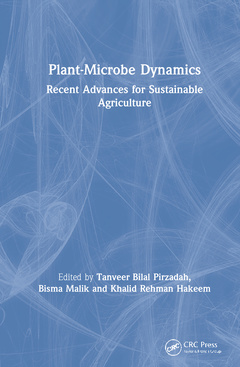Plant-Microbe Dynamics Recent Advances for Sustainable Agriculture
Coordonnateurs : Pirzadah Tanveer Bilal, Malik Bisma, Hakeem Khalid Rehman

Plants and microbes have co-evolved and interacted with each other in nature. Understanding the complex nature of the plant-microbe interface can pave the way for novel strategies to improve plant productivity in an eco-friendly manner. The microbes associated with plants, often called plant microbiota, are an integral part of plant life. The significance of the plant microbiome is a reliable approach toward sustainability to meet future food crises and rejuvenate soil health. Profiling plant-associate microbiomes (genome assemblies of all microbes) is an emerging concept in understanding plant-microbe interactions. Microbiota extends the plant capacity to acclimatize fluctuating environmental conditions through several mechanisms. Thus, unraveling the mystery of plant-microbe dynamics through latest technologies to better understand the role of metabolites and signal pathway mechanisms is very important.
This book shares the latest insight on omics technologies to unravel plant-microbe dynamic interactions and other novel phytotechnologies for cleaning contaminated soils. Besides, it also provides brief insight on the recently discovered clustered regularly interspaced short palindromic repeats CRISPR-Cas9, which is a genome editing tool to explore plant-microbe interactions and how this genome editing tool helps to improve the ability of microbes/plants to combat abiotic/biotic stresses.
1. Plant-Microbe Interactions
Raffia Siddique and Alvina Gul
2. Secondary Metabolites: Rapid Evolving Weapon in the Plant-Microbe
Warfare
Irum Iqrar, Ashia Alam, Muhammad Numan, and Zabta Khan Shinwari
3. Unravel the Mystery of Plant-Microbe Interactions: Biotechnological Perspective
Nazir Ahmad Malik, Mohammad Saleem Wani, Naseema Aqbar Wani,
and Younas Rasheed Tantray
4. Phosphate Solubilizing Bacteria: A Neglected Bioresource for Ameliorating Biotic Stress in Plants
Rajinder Kaur, Sukhminderjit Kaur, and Navneet Kaur
5. Biochar: A Strategy for Rejuvenating Soil Health and Carbon Sequestration
Mahima Begum, Milon Jyoti Konwar, and Gayatri Goswami Kandali
6. Role of Metabolomics in Deciphering the Plant-Microbe Interaction
Younas Rasheed Tantray, Naseema Wani, Nazir Ahmed Malik,
Mohammad Saleem Wani, and Ishrat Jan
7. Arsenic Phytotoxicity via the Membrane Transporters and Its Mechanism of Action and Detoxification in Plant Cells
Amna, Sadia Qamar, and M. Irfan Qureshi
8. Phytoremediation: A Unified Remedial System to Tackle Pesticide Pollution
Sajid Muhammad, Faisal Islam, Pingchuan Deng, Mukhtar Ahmad,
Md. Mosfeq- Ul-Hasan, Ali Muhammad, Mehmood Jan, Muhammad Afzal,
Asad Ullah Khan, Muhammad Zeeshan, Syed Muhammad Azam,
and Syed Mehar Ali Shah
9. Present Scenario of Plant Growth Promoting Microbes and Technologies
Used for Biofertilizer Development Nitu Rani, Rajinder Kaur, and Sukhminderjit Kaur
10. Recent Biotechnological Applications of Archaeal Domain
Ruth Gill, Rajinder Kaur, Nitu Rani, and Sukhminderjit Kaur
11. Role of Fungal Endophytes in Improving Abiotic Stress Tolerance in Plants
Bushra Jan, Zafar A. Reshi, and F. A. Mohiddin
12. Microbes and Their Role in Abiotic Stress Tolerance in Food Crops
Anjali Pathak, Mir Sajad Rabani, Mahendra K. Gupta, Shivani Tripathi,
and Sadhna Pandey
13. Plant Growth Promoting Rhizobacteria (PGPR): Eco-Friendly Approach for Sustainable Agriculture
Bushra Jan, Sheikh Sajad, Zafar A. Reshi, and F. A. Mohiddin
14. Omics Technologies to Unravel Plant-Microbe Interactions
Amrina Shafi, Insha Zahoor, and Huma Habib
15. Cas9 Technology: An Innovative Approach to Enhance Phytoremediation
Deepu Pandita
Tanveer Bilal Pirzadah, PhD is Assistant Professor at University Centre for Research and Development (UCRD); Chandigarh University, Punjab, India. After completing his doctorate (Bioresources; specialization in Plant Stress Physiology and Biofuels) from University of Kashmir, Srinagar, India, in 2017, he worked as an Assistant Professor at the Cluster University Srinagar. Dr. Tanveer has about 9 years of research and teaching experience in bioresources management, biofuels, plant stress physiology, biotechnology and molecular biology, medicinal plant research, plant-metal interactions as well as in environmental studies. He also has to his credit more than 30 research publications in peer-reviewed international journals and more than 30 book chapters in edited volumes and 02 edited book with international publishers. At present, Dr. Tanveer serves as an editorial board member and reviewer of several international scientific journals. He is also member of the World Academy of Sciences and Plantae group of the American Society of Plant Biologists. Currently, Dr. Tanveer is engaged in studying the plant processes at proteomic, metabolomic and molecular level to better understand the dynamic plant-metal interactions.
Bisma Malik, PhD is Assistant Professor at University Centre for Research and Development (UCRD); Chandigarh University, Punjab, India. She is the recipient of Women scientist (WOS-A) fellow from DST, Government of India. She is actively engaged in research and has 9 years of research experience in plant stress physiology, molecular biology and environmental studies. She has worked on stress biology and genetic diversity of chicory-an untapped Bioresource from Kashmir Himalaya. She has to her credit 30 publications in international journals and 30 book chapters of International repute. Currently, Dr. Bismais engaged in studying plant endophytes as a promising source of lead compounds that has immense potential in
Date de parution : 06-2021
17.8x25.4 cm
Thèmes de Plant-Microbe Dynamics :
Mots-clés :
Plant Microbe Interactions; Rejuvenate soil health; ISR; Sustainable agriculture; PGPRs; Plant–microbe interactions; Abiotic Stresses; Plant-microbe dynamics; PGPR Strain; Plant microbiota; Acc Deaminase; PGPB; Phosphate Solubilizing Bacteria; Abiotic Stress Tolerance; Plant Growth Promoting; Soil Fertility; Rhizospheric Region; Endophytic Fungi; Fungal Endophytes; Pm Association; Biochar Application; PSB Strain; Biochar Amendment; Single Guide RNA; Soil Aggregate Stability; CRISPR Cas9 Genome Editing; CRISPR Cas9 System; Acc Deaminase Activity; Rice Husk Biochar; Biochar Produced



